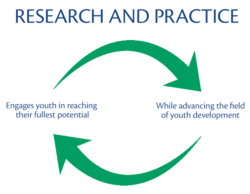Youth Development Resources

- Practice: 4-H is consistent with scientifically valid research in youth development, education, child, human, and cognitive development. 4-H is able to demonstrate, or likely to demonstrate, through research and/or evaluative data, a positive impact on youth served.
- Research: 4-H is a contributor to research and/or the extension of knowledge in youth development.
4-H Youth Development Advisors engage in various research and evaluation projects. These research and evaluation projects inform promising practice as well as contribute to the field of positive youth development and nonformal education. We use our science base to anticipate problems and develop practical solutions in the communities we serve. By sharing our efforts with other professionals, we leverage additional resources and expand our impact.
TEACHING AND LEARNING IN OUT-OF-SCHOOL TIME
Worker, S. M. (2017). Volunteer educators bring their own ideas about effective teaching to a 4-H curriculum. California Agriculture, 71(4).
Youth programs implemented during out-of-school time often rely on volunteers. These volunteers are responsible for selecting and adapting curriculum and facilitating activities, so their pedagogical practices become primary contributors to program quality, and ultimately, youth outcomes. To describe volunteers' pedagogical practices, I conducted a qualitative case study at three sites where volunteer educators were implementing a design-based 4-H curriculum. The curriculum advanced youth scientific literacy by supporting scientific inquiry in conjunction with planning, designing and making shareable artifacts. Through detailed observations, videos and focus groups, I identified six common pedagogical practices, though educators differed widely in which ones they used. Pragmatic and structural constraints shaped their choices, as did their professional identification as engineers, or not, and their relative comfort with engineering. To support volunteer educators in implementing a learner-centered educational program, curricula designers might be more specific in recommending and explaining pedagogical practices, and program managers might better train volunteer educators in those preferred practices.
Worker, S. M., Ouellette, K. L., & Maille, A. (2017, May). Redefining the concept of learning in Cooperative Extension. Journal of Extension, 55(3). Article 3FEA3.
For Extension educational programs to meet the educational needs of today's youths, families, and communities, Extension needs to expand "what counts" as learning. The purpose of this article is to define learning in the context of Extension. We summarize key aspects of the educational research literature by comparing two prevailing metaphors for learning: acquisition and participation. On the basis of the two metaphors, we developed a definition of learning, and we discuss the related implications for program and curriculum development, pedagogy, professional development, and assessment of learning.
SCIENCE EDUCATION
Worker, S. M. (2016). Examining tensions among youth, adults, and curriculum as co-designers in 4-H STEM learning through design programs. In C. K. Looi, J. L., Polman, U. Cress, P. Reimann (Eds.), Transforming Learning, Empowering Learners: The International Conference of the Learning Sciences (ICLS) 2016, Volume 1 (pp. 322-329). Singapore: International Society of the Learning Sciences.
This research study explored the relationships between three types of co-designers in 4-H STEM learning through design programs: youth participants, volunteer educators, and the curriculum. Each co-designer was involved in a process of planning and making in order to accomplish a goal to satisfy requirements subject to constraints. The enactment of the learning environment revealed tensions between the co-designers evidenced in participation structures (negotiated between the curriculum and educators); abstract versus concrete approaches (between the educators and youth); and tensions amongst youth peers while engaging in small group design teams (between curriculum and youth).
Smith, M., Worker, S., Ambrose, A., & Schmitt-McQuitty, L. (2015). Scientific literacy: California 4-H defines it from citizens’ perspective. California Agriculture, 69(2), 92-97.
Scientific literacy is an important educational and societal goal. Measuring scientific literacy, however, has been problematic because there is no consensus regarding the meaning of scientific literacy. Most definitions focus on the content and processes of major science disciplines, ignoring social factors and citizens’ needs. The authors developed a definition of scientific literacy for the California 4-H Program from the citizen's perspective, concentrating on real-world science-related situations. The definition includes four anchor points: science content; scientific reasoning skills; interest in and attitudes toward science; and contribution through applied participation. The definition provides the California 4-H Science, Engineering, and Technology Initiative with a framework for future science curriculum and program development and implementation, educator professional development, and evaluation.
Worker, S.M. & Smith, M.H. (2014). Curriculum and professional development for OST science education: Lessons learned from California 4-H. Afterschool Matters, 20, 21-27.
A wide variety of out-of-school time (OST) programs across the U.S. offer science education opportunities that cover many scientific disciplines and use diverse pedagogical practices (National Research Council [NRC], 2009). However, to improve youth’s scientific literacy, OST educators need to “have the disposition and repertoire of practices and tools at their disposal to help learners expand on their everyday knowledge and skill to learn science” (NRC, 2009, p. 309). Thus, OST educators need both essential pedagogical skills and high-quality curriculum materials.
CURRICULUM
Smith, M., Worker, S., Meehan, C., Schmitt-McQuitty, L., Ambrose, A., Brian, K., & Schoenfelder, E. (2017). Defining and developing curricula in the context of Cooperative Extension. Journal of Extension, 55(2).
Effective curricula are considered to be the cornerstone of successful programming in Extension. However, there is no universal operationalized definition of the term curriculum as it applies to Extension. Additionally, the development of curricula requires a systematic process that takes into account numerous factors. We provide an operational definition of curriculum by describing the parts of a curriculum, discussing the organization of those elements, and recommending theoretical frameworks that complement the learn-by-doing approach used in Extension. We also describe strategies to guide curriculum development, adaptation, and evaluation that will help advance the potential of Extension curricula to achieve their intended outcomes.
